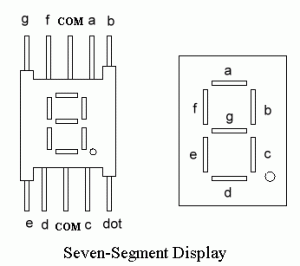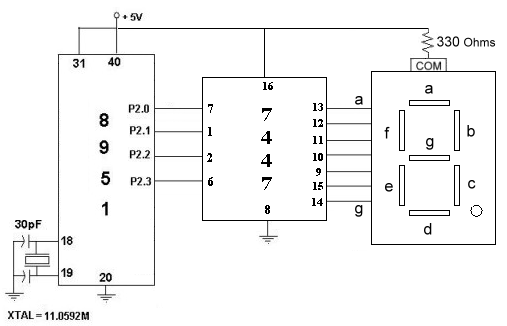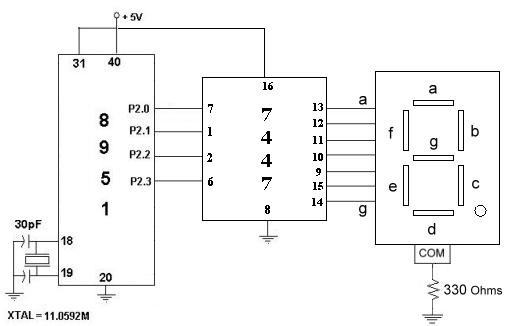Interfacing 7-segment display using 7447 decoder
The Light Emitting Diode (LED), finds its place in many applications in this modern electronic fields. One of them is the Seven Segment Display. Seven-segment displays contains the arrangement of the LEDs in “Eight” (8) passion, and a Dot (.) with a common electrode, lead (Anode or Cathode). The purpose of arranging it in that passion is that we can make any number out of that by switching ON and OFF the particular LED’s. Here is the block diagram of the Seven Segment LED arrangement.
Pin configuration of a seven segment display:

LED’s are basically of two types:
- Common Cathode (CC)
All the 8 anode legs uses only one cathode, which is common. - Common Anode (CA)
The common leg for all the cathode is of Anode type.
For the discussion purpose, we use CC LED, where by just reversing the logical voltages we can implement the same for CA LED also.
In a CC LED, all the 8 legs (’a’ through ‘h’) are of anode type and the common cathode will be connected to the GND of the supply. By energizing any of the legs with +5 Volts will lead to switch the correspondent segment ON. In the microprocessor binary system, 0Volts will be considered as Binary 0, and 5Volts will be considered as Binary1. Considering these two condition, we can make an arrangement as the microcontroller gives OUT the 0s and 1s through its ports, which is connected to the 8 legs of the LED. Of course, we can control the Port Output; implicitly we can Switch-ON required legs of the display.
There 2 methods of interfacing LED with the Microcontroller Intel 8051/8951.
- Using lookup table. This uses 7 output pins of microcontroller
- Using 7447 decoder. This method uses 4 output pins of microcontroller
The difference between the two main methods is simple and clear. In both the cases, microcontroller communicates with external world through its ports. But, in the 1st case, we connect all the 8 pins of the port directly to the LED and control the voltage through the ports manually to display the desired number. But, in the second case, we send the BCD of the number that we wanted to display to a middleware IC 7447, the BCD to LED code converter, which by itself gives out the correspondent 7 segment codes to the LED.
Here we explain using lookup table. Click here for the method “using 7447 decoder”
Using 7447 decoder:
The IC7447 is a BCD to 7-segment pattern converter. This setup is the advanced form of the <previous> setup where we entered the patterns manually to display the desired character. Here in this case, the IC7447 takes the Binary Coded Decimal (BCD) as the input and outputs the relevant 7 segment code. We connect first four pins of the microcontroller Port 2 to the 7447 and the Output 8 pins of 7447 to the 8 legs of the LED as shown in the figure. Te circuit diagrams are shown below, the first figure is interfacing the CA LED where as the second is of CC LED. The number required to display is sent as the lower nibble of the Port 2 of the Microcontroller. The 7447 converts the four input bits (BCD) to their corresponding 7-segment codes. The outputs of the 7447 are connected to the 7-segment display

Circuit diagram for interfacing Common Anode 7-Segment Display

Circuit diagram for Common Cathode 7-Segment Display
Program:
This program displays characters 0 through 9 on seven-segment display
using IC 7447 as the middle wear.
again: mov a,#00h ; Start form zero
up: mov p2, a ; Move to Port 2
mov r3,#255 ; Delay
D1: mov r1,#255
D: djnz r1,D
djnz r3,D1
inc a
cjne a,#0ah,up
sjmp again